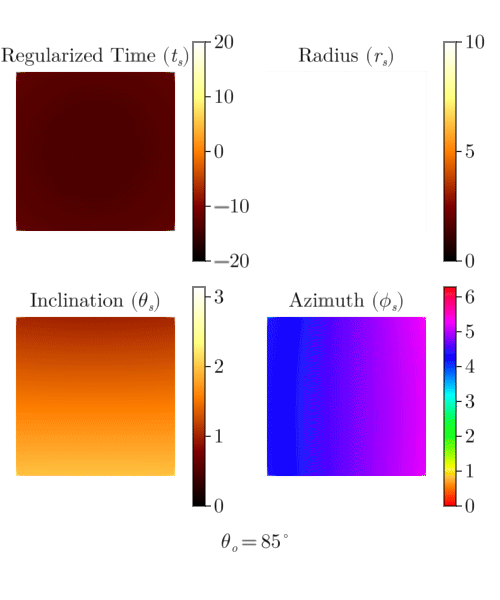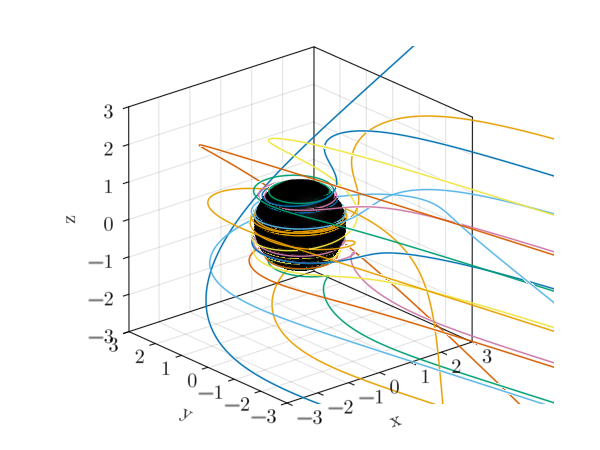Rays parameterized with Mino time
In this example, we will raytrace the region around a Kerr black hole as seen by an observer stationed at infinity. We will return the coordinates associated with a ray by marching along the ray's Mino time parameter from the assymptotic observer.
First, let's import Krang and CairoMakie for plotting.
using Krang
import GLMakie as GLMk
GLMk.Makie.inline!(true)
curr_theme = GLMk.Theme(# Makie theme
fontsize=20,
Axis=(
xticksvisible=false,
xticklabelsvisible=false,
yticksvisible=false,
yticklabelsvisible=false,
leftspinevisible=false,
rightspinevisible=false,
topspinevisible=false,
bottomspinevisible=false,
titlefontsize=30,
),
)
GLMk.set_theme!(GLMk.merge(curr_theme, GLMk.theme_latexfonts()))We will use a 0.99 spin Kerr black hole viewed by an asymptotic observer at an inclination angle of θo=π/4.
metric = Krang.Kerr(0.99); # Kerr spacetime with 0.99 spin
θo = 85 * π / 180; # Observer inclination angle with respect to spin axis
sze = 200; # Number of pixels along each axis of the screen
ρmax = 5; # Size of the screenWe will define a camera with the above parameters. The SlowLightIntensityCamera pre-calculates information about the spacetime and the observer's screen to speed up the raytracing for slow light applications.
camera = Krang.SlowLightIntensityCamera(metric, θo, -ρmax, ρmax, -ρmax, ρmax, sze);Let us now create a figure to plot the emission coordinates on.
fig = GLMk.Figure(resolution=(500, 600));┌ Warning: Found `resolution` in the theme when creating a `Scene`. The `resolution` keyword for `Scene`s and `Figure`s has been deprecated. Use `Figure(; size = ...` or `Scene(; size = ...)` instead, which better reflects that this is a unitless size and not a pixel resolution. The key could also come from `set_theme!` calls or related theming functions.
└ @ Makie ~/.julia/packages/Makie/6c4lt/src/scenes.jl:229We will create a loop to plot the emission coordinates for each θs.
recording = GLMk.record(fig, "raytrace.gif", range(0.1, 3, length=290), framerate=15) do τ
GLMk.empty!(fig)
coordinates = zeros(4, size(camera.screen.pixels)...) # Pre allocated array to store coordinates
emission_coordinates!(coordinates, camera, τ)
time = coordinates[1,:,:]
radius = coordinates[2,:,:]
inclination = coordinates[3,:,:]
azimuth = mod2pi.(coordinates[4,:,:])
data = (time, radius, inclination, azimuth)
titles = (GLMk.L"\text{Regularized Time }(t_s)", GLMk.L"\text{Radius }(r_s)", GLMk.L"\text{Inclination }(\theta_s)", GLMk.L"\text{Azimuth } (\phi_s)")
colormaps = (:afmhot, :afmhot, :afmhot, :hsv)
colorrange = ((-20, 20), (0, 10.0), (0,π), (0, 2π))
indices = ((1,1), ())
for i in 1:4
hm = GLMk.heatmap!(
GLMk.Axis(getindex(fig, (i > 2 ? 2 : 1), (iszero(i%2) ? 3 : 1)); aspect=1, title=titles[i]),
data[i],
colormap=colormaps[i],
colorrange=colorrange[i]
)
cb = GLMk.Colorbar(fig[(i > 2 ? 2 : 1), (iszero(i%2) ? 3 : 1)+1], hm; labelsize=30, ticklabelsize=20)
end
ax = GLMk.Axis(fig[3, 1:3], height=60)
GLMk.hidedecorations!(ax)
GLMk.text!(ax,0,100; text=GLMk.L"θ_o=%$(Int(floor(θo*180/π)))^\circ")
GLMk.rowgap!(fig.layout, 1, GLMk.Fixed(0))
end"raytrace.gif"
camera = Krang.SlowLightIntensityCamera(metric, θo, -3, 3, -3, 3, 4);
fig = GLMk.Figure()
ax = GLMk.Axis3(fig[1,1], aspect=(1,1,1))
GLMk.xlims!(ax, (-3, 3))
GLMk.ylims!(ax, (-3, 3))
GLMk.zlims!(ax, (-3, 3))
lines_to_plot = []
lines_to_plot = Krang.generate_ray.(camera.screen.pixels, 5_000)
sphere = GLMk.Sphere(GLMk.Point(0.0,0.0,0.0), horizon(metric))
GLMk.mesh!(ax, sphere, color=:black) # Sphere to represent black hole
for i in lines_to_plot; GLMk.lines!(ax, i) end
fig
GLMk.save("mino_time_rays.png", fig)
This page was generated using Literate.jl.